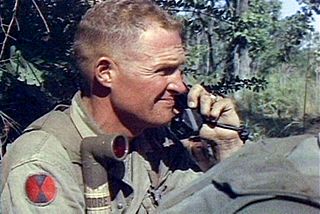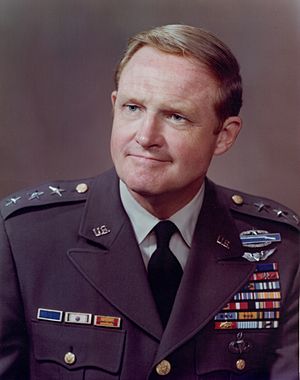Hal Moore facts for kids
Quick facts for kids
Harold Gregory Moore Jr.
|
|
|---|---|

Moore at the United States Military Academy in May 2010
|
|
| Nickname(s) | "Hal", "Yellow Hair" |
| Born | February 13, 1922 Bardstown, Kentucky |
| Died | February 10, 2017 (aged 94) Auburn, Alabama |
| Buried |
Fort Benning Post Cemetery
|
| Allegiance | United States |
| Service/ |
United States Army |
| Years of service | 1945–1977 |
| Rank | Lieutenant general |
| Commands held | Army Military Personnel Center Fort Ord Army Training Center 7th Infantry Division 3rd Brigade, 1st Cavalry Division 1st Battalion, 7th Cavalry Regiment 2nd Battalion, 23rd Infantry Regiment |
| Battles/wars | Korean War Vietnam War
|
| Awards | Distinguished Service Cross Army Distinguished Service Medal Legion of Merit (3) Bronze Star Medal (4) w/ "V" Device Purple Heart Air Medal (9) |
| Spouse(s) |
Julia Compton Moore
(m. 1949; died 2004) |
| Relations | 5 children, 12 grandchildren |
| Other work | We Were Soldiers Once… And Young We Are Soldiers Still: A Journey Back to the Battlefields of Vietnam Executive Vice-President of the Crested Butte Ski Area, Colorado |
Harold Gregory Moore Jr. (February 13, 1922 – February 10, 2017) was a brave United States Army general and a respected author. He received the Distinguished Service Cross, which is the second-highest award for bravery in the U.S. military. He was also the first person from his West Point class of 1945 to become a brigadier general, major general, and lieutenant general.
Moore is best known for leading the 1st Battalion, 7th Cavalry Regiment, as a lieutenant colonel during the Battle of Ia Drang in 1965. This important battle happened during the Vietnam War. The story of the battle was told in the popular 1992 book We Were Soldiers Once… and Young, which Moore co-wrote. It was later made into a movie called We Were Soldiers in 2002, where Mel Gibson played him. Moore was also given the special title of "honorary colonel" for his regiment.
He also received the Order of Saint Maurice and the Distinguished Graduate Award from the West Point Association of Graduates.
Contents
Early Life and Education
Harold Moore was born on February 13, 1922, in Bardstown, Kentucky. He was the oldest of four children. His father worked as an insurance agent, and his mother was a homemaker. When he was 17, Moore wanted to attend the U.S. Military Academy at West Point, New York. He believed his chances would be better in a bigger city. So, he moved to Washington, D.C., and worked in a U.S. Senate warehouse.
While working, Moore finished high school at night, graduating from St. Joseph Preparatory School in 1940. He also studied at George Washington University at night for two years. He was waiting for a chance to get into West Point. A congressman offered him a spot at the Naval Academy, but Moore wanted to go to the Military Academy. He found another congressman who agreed to trade spots, and Moore finally got his dream appointment to West Point.
Military Career
West Point Training
Moore started at West Point on July 15, 1942, shortly after the United States entered World War II. His first summer was spent in "Beast Barracks," a tough training period. He was a great shot with the M-1 Garand rifle. Because of the war, his class had to finish in three years instead of the usual four. Moore found the math and science classes very challenging. He often studied late into the night to keep up. He focused on his studies and didn't have much time for other activities. He graduated from West Point on June 5, 1945, and became a second lieutenant in the infantry.
Early Army Assignments
After West Point, Moore went to the Infantry Officer Basic Course in Fort Benning, Georgia. He then joined jump school in Tokyo, Japan, and became an expert in parachuting. His first assignment was with the 187th Glider Infantry Regiment in Japan from 1945 to 1948. He later joined the 82nd Airborne Division at Fort Bragg. He volunteered for a special unit that tested new parachutes. He made over 150 jumps with this unit and eventually became a jumpmaster, completing over 300 jumps in his career.
Korean War Experience
During the Korean War (1950–1953), Moore attended a course to prepare him for leadership roles. In June 1952, he was sent to Korea with the 7th Infantry Division. As a captain, he commanded a heavy mortar company in combat. He later became an assistant chief-of-staff for operations. To be promoted to major, he needed to command an infantry company in combat, which he did, allowing him to advance in rank.
Back in the USA
In 1954, Moore returned to West Point to teach infantry tactics for three years. One of his students was Norman Schwarzkopf, who later became a famous general. Schwarzkopf said Moore was one of his heroes and inspired him to join the infantry. Moore also studied the battles between French and Vietnamese forces at Điện Biên Phủ.
He then attended the Command and General Staff College in Kansas and worked at the Pentagon, helping to develop new airborne equipment and tactics. From 1960 to 1963, he worked for NATO in Norway.
In 1964, now a lieutenant colonel, Moore studied at the Naval War College and earned a master's degree in International Relations. He then commanded the 2nd Battalion, 23rd Infantry, which was part of the 11th Air Assault Division. This division trained in air assault tactics. In July 1965, President Lyndon Johnson announced that this "Airmobile Division" would go to Vietnam. Moore's battalion was renamed the 1st Battalion, 7th Cavalry Regiment, 1st Cavalry Division. This was the same regiment that George Custer commanded almost a century earlier. Moore's unit left for Vietnam in August 1965.
Vietnam War Service
The Battle of Ia Drang
On November 14, 1965, Lt. Col. Moore led his battalion into the Battle of Ia Drang. His troops were surrounded by many North Vietnamese Army (NVA) soldiers. They had no clear way to leave the area. Despite being greatly outnumbered, Moore and his soldiers fought bravely and held their ground. Moore believed, "there is always one more thing you can do to increase your odds of success." His leadership and his troops' courage helped them survive.
Moore, who had blond hair, was known as "Yellow Hair" by his soldiers. This was a playful nod to General George Armstrong Custer, who also commanded the 7th Cavalry Regiment. For his amazing bravery at Ia Drang, Moore received the Distinguished Service Cross. After the battle, he was promoted to colonel and took command of the 3rd Brigade.
After Vietnam
After his service in Vietnam, Moore worked at the Pentagon. He then went to Harvard University, where he earned another master's degree in International Relations in 1968. He returned to the Pentagon and helped plan the withdrawal of some U.S. troops from Vietnam. On August 31, 1968, Moore was promoted to brigadier general.
In July 1969, he was assigned to the Eighth Army in South Korea. Tensions were high there, and Moore worked to improve morale and address issues among the troops. He became a major general in 1970 and focused on leadership training and promoting equal opportunity. He also started several sports programs to boost morale.
From 1971 to 1973, he commanded the Army Training Center at Fort Ord, California. He helped prepare the Army for a time when soldiers would volunteer instead of being drafted. In 1973, he became the deputy chief of staff for personnel for the U.S. Army. He handled recruiting and the reduction of forces after the Vietnam War. Moore retired from the Army on August 1, 1977, after 32 years of service.
Personal Life
While stationed at Fort Bragg, Moore met Julia B. Compton. They married on November 22, 1949. After retiring in 1977, Moore became the Executive President of the Crested Butte Ski Area in Colorado.
In June 2009, Moore, at 87 years old, attended the opening of the National Infantry Museum in Columbus, Georgia. The museum features a life-size display of the Battle of Ia Drang. Hal and Julia Moore had five children: Greg, Steve, Julie, Cecile, and David. They also had twelve grandchildren. Two of their sons followed in their father's footsteps and became U.S. Army officers.
Harold Moore passed away from a stroke on February 10, 2017, just three days before his 95th birthday. He was buried with full military honors at Fort Benning Post Cemetery on February 17, 2017, next to his wife, who had passed away in 2004.
Awards and Honors
The Purple Heart Story
Even though it was listed among his awards, Moore never wore the Purple Heart medal. He even tried to return it to the Army. In a letter from January 1968, he explained that he felt he didn't truly earn it for a small injury he received in Vietnam in 1965. He believed the injury was too minor to deserve such an important award. The Army, however, declined his request, stating that the award was part of his official record.
List of Awards and Decorations
Moore received many awards and decorations for his service, including:
- Distinguished Service Cross
- Army Distinguished Service Medal
- Legion of Merit (three awards)
- Bronze Star Medal (four awards, including one for valor)
- Purple Heart
- Air Medal (nine awards)
- Combat Infantryman Badge
- Basic Army Aviator Badge
- US Army Presidential Unit Citation
- Republic of Korea Presidential Unit Citation
- Republic of Vietnam Gallantry Cross Unit Citation
- Master Parachutist Badge
- Original Air Assault Badge
- Army Staff Identification Badge
- Office of the Secretary of Defense Identification Badge
Other Recognition
- He received the Order of Saint Maurice from the National Infantry Association.
- He was given the Distinguished Graduate Award from the West Point Association of Graduates.
- The The Naming Commission has suggested that Fort Benning be renamed Fort Moore, honoring both Hal Moore and his wife Julia Moore.
See also
 In Spanish: Hal Moore para niños
In Spanish: Hal Moore para niños




